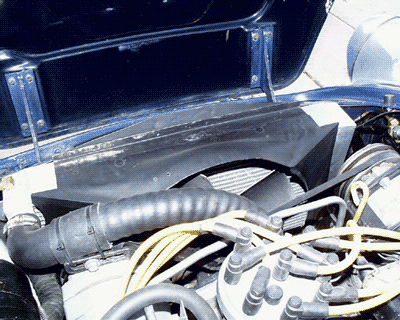Preparing A Tiger To Live In The Arizona Desert
By Cullen Bennett
B9472658
September 15, 1999
Preface: - "In The Beginning"
Anyone who has owned a stock Tiger for any time, in an even
"slightly" warm environment, will readily attest to the fact
that they run HOT on the thermometer. This fact is further aggravated
when additional modifications are made to "improve" the
performance abilities. These include such items such as high performance
cams, oversize cylinder bore, higher compression and the list goes on. The
basic physics of more power generated, dictates that for a fixed efficiency,
the power not utilized in the process of accelerating a mass (the car) is
manifested in the form of additional heat. The more of this heat that can
be dissipated the less the car accumulates or "heats up". The
primary function of the cooling system in a car is to radiate this excess
heat into the surrounding environment. Thus, the "radiator"
performs just this task by radiating the heat from a higher temperature
source (i.e. the engine) to the cooler surroundings. In my case this
cooler environment is the Arizona desert where I have personally been in
a 123 degree Fahrenheit ambient temperature. That’s when walking on
an asphalt parking lot feels like you are walking on a mattress. Sort
of spongy and soft. You can say all that you want about it being a
"dry heat" it's just plain HOT! The heat transfer out of the
engine is accomplished by passing ambient air through the fins of the
radiator and then allowed to escape back into the environment.
In the Beginning, I had been using the stainless steel flex fan
that the previous owner had left in the bottom of the trunk when he pulled
the motor out. ( I bought the car with the engine sitting next to it on
the ground. It had been that way for 13 years.) Also at that point in
time the radiator was still the original three row brass and there was
no shroud at all. I had an real indication that things were not going to
be easy after the first time I drove the car around the block after
rebuilding the engine and pulled back into the garage. I had only gone
out for maybe a couple of miles and it wasn't particularly hot weather
either. Upon shutting the engine off I heard the proverbial
gurgle....gurgle...puke. All of the new antifreeze and distilled water
was running out of the garage down the driveway. There was an immediate
discount on my part that this episode was related to a "tight"
engine, and things would get better. Well after about the fourth
episode of this identical behavior, I was resigned to the fact that
"Houston..., We have a problem".
Part One; "In search of The Radiant One"
My first reaction was to have the original radiator
"cleaned out". Obviously it had worked at one time, cars just
don't go around with the thermometer pegged all the time. I took it to
the radiator shop and they boiled it and rodded the tubes out, all to
no avail. Next, they said they could put a 4 row core into it, but that
it "might" still have an occasional problem. At this point,
someone suggested going with an aluminum radiator, but, that would be
big bucks ($$$$). Actually compared to what they wanted to charge me
for a 4 row make-over that "might" still have a problem, the
differential cost wasn't really all that bad. I asked around and found
a shop across town that is one of the best in the country for
manufacturing aluminum radiators. It even has favorable acclaim from
some of the big-rig 18 wheelers that haul heavy stuff across the desert
on a regular basis. I figured if it's good enough for them, it's good
enough for me.
The radiator that I chose to go with was custom manufactured
by:
 **
**
